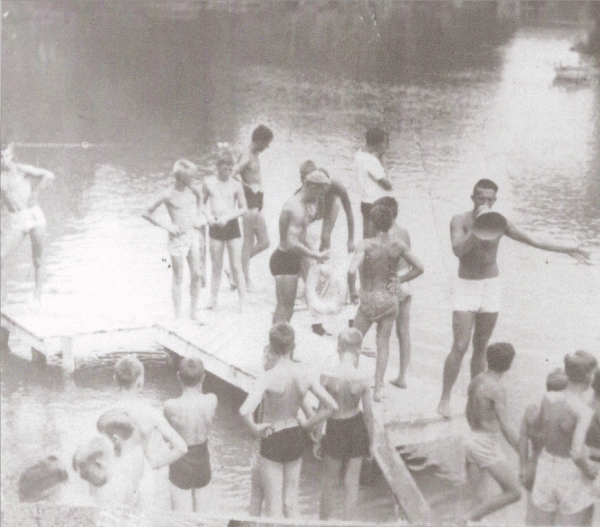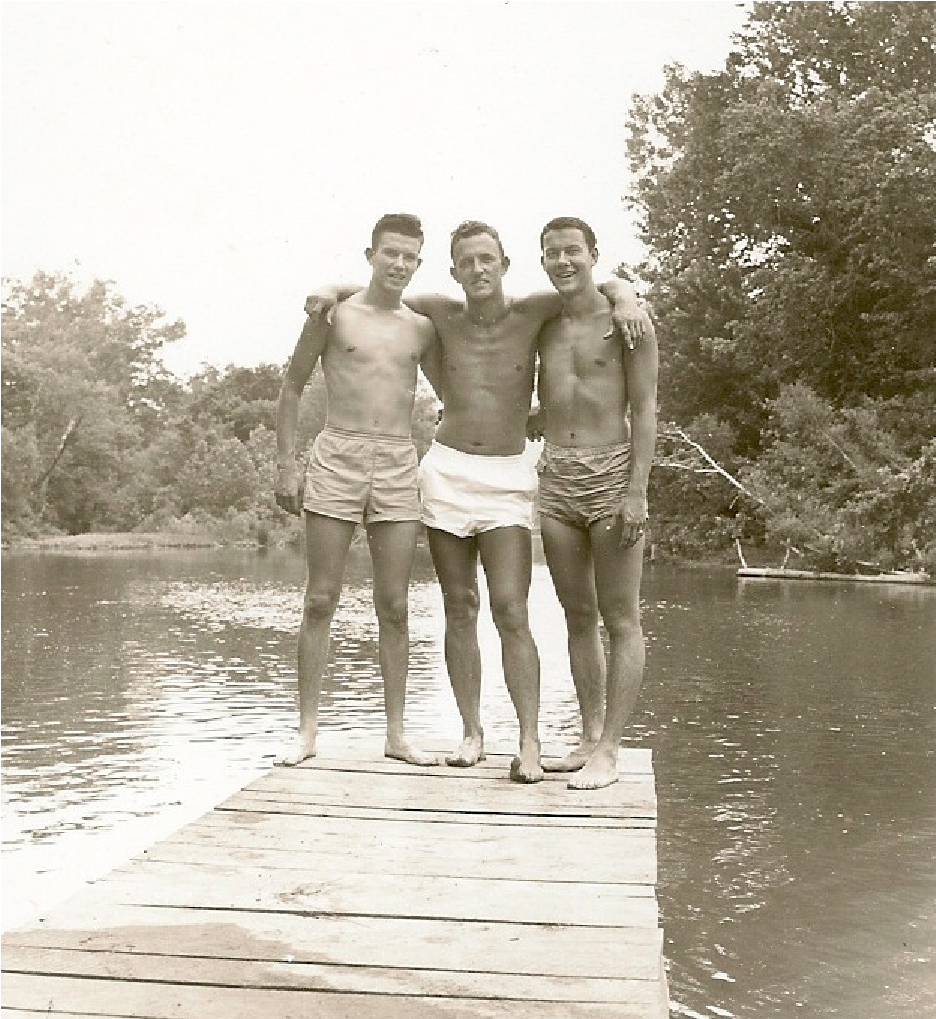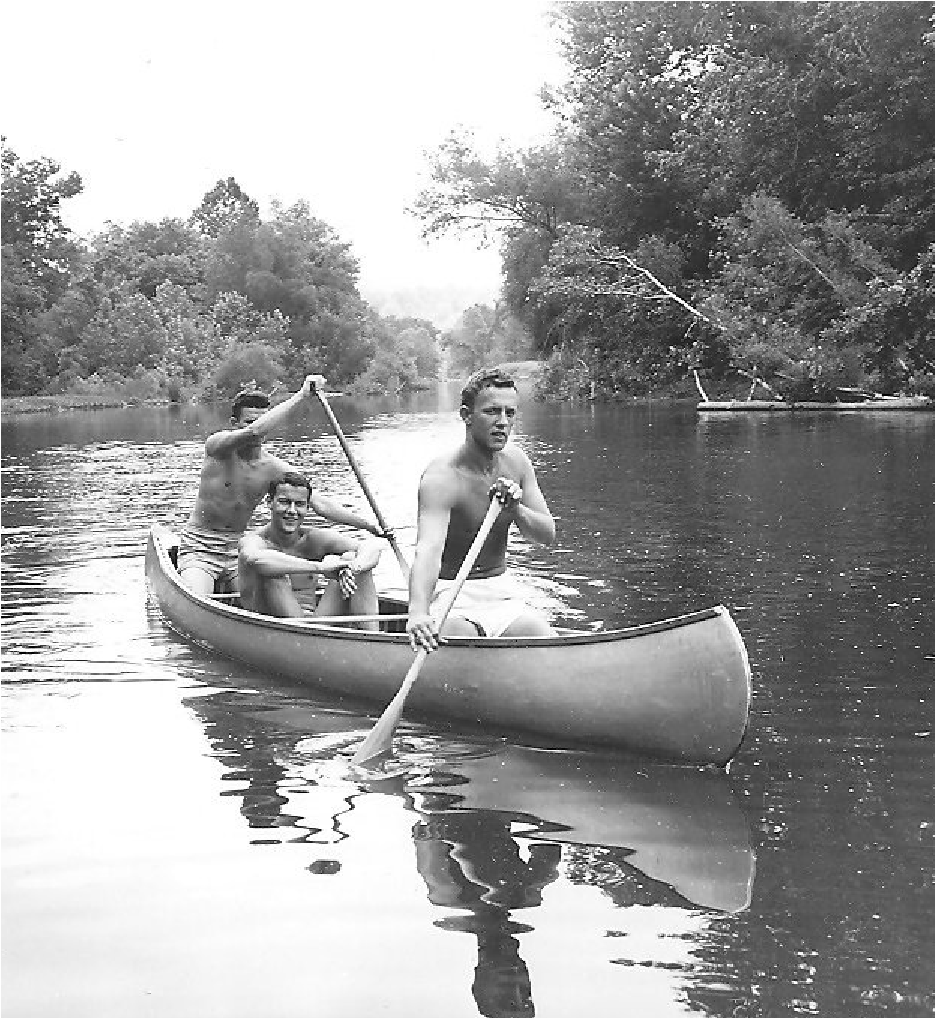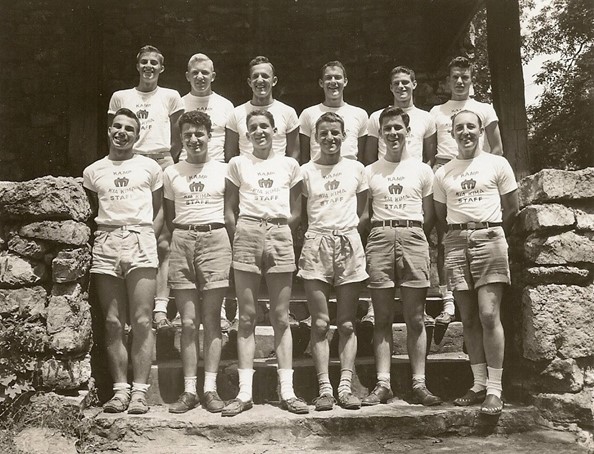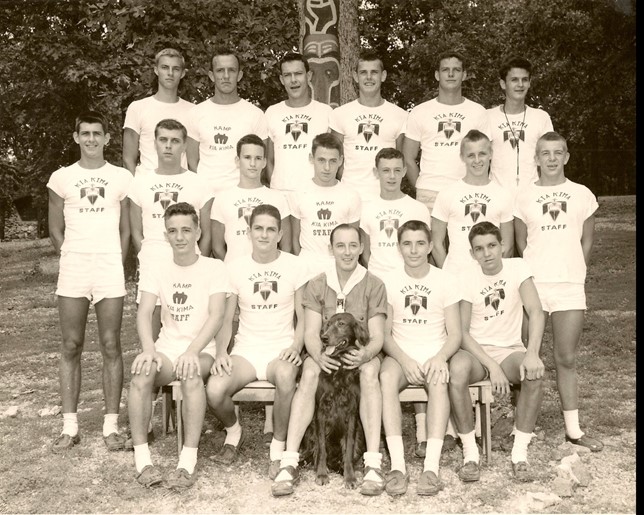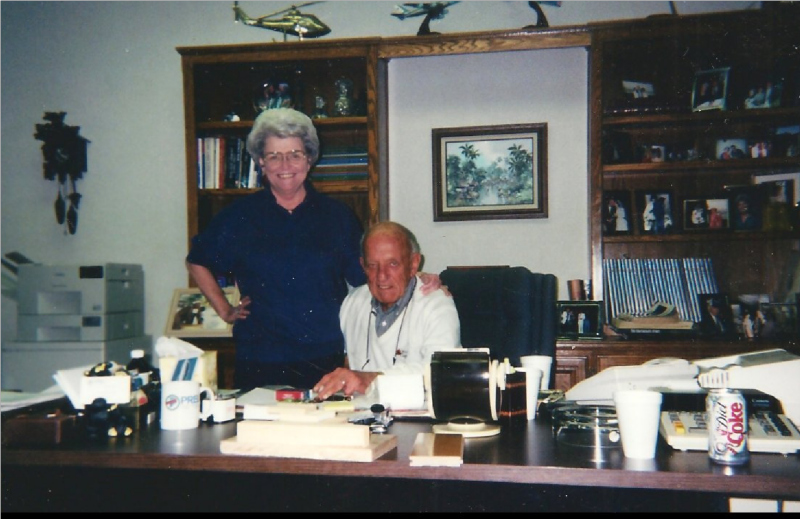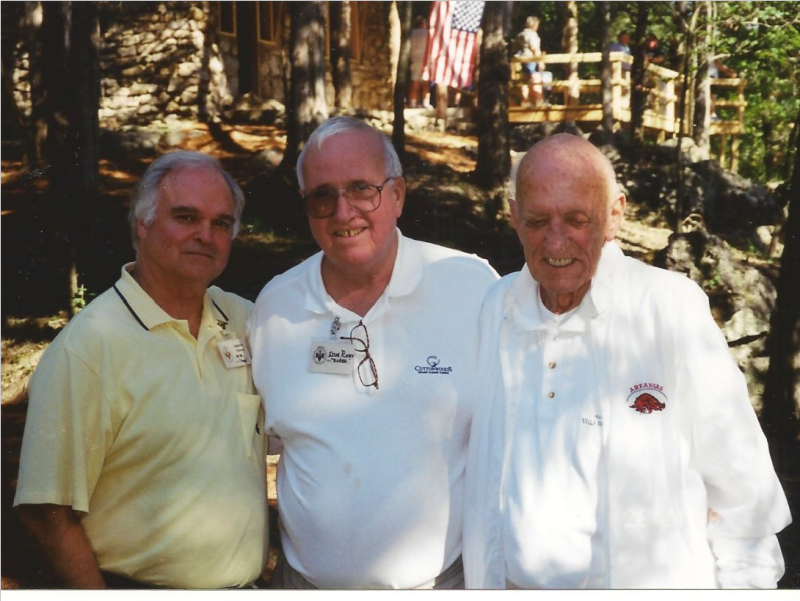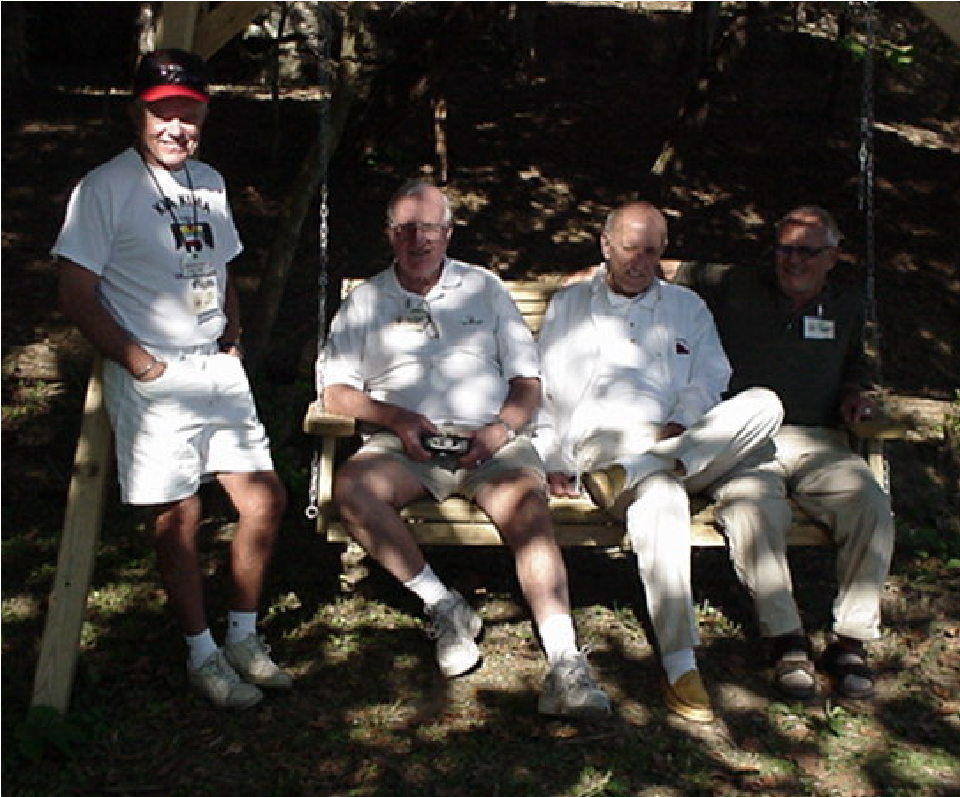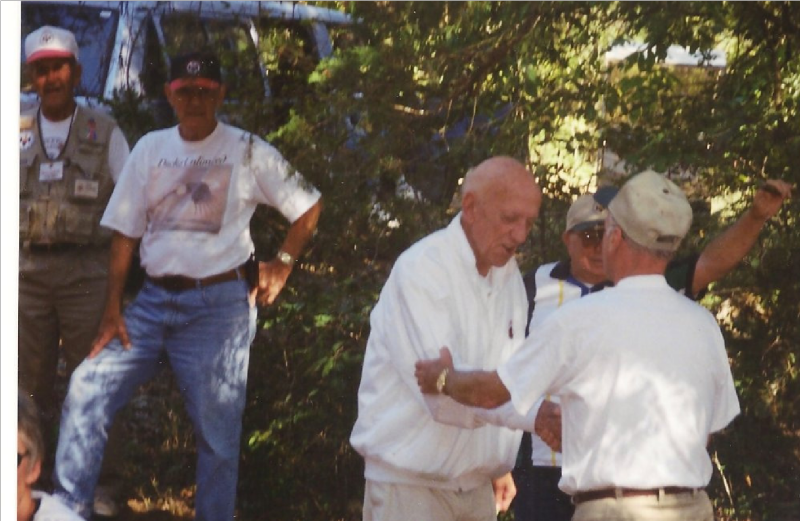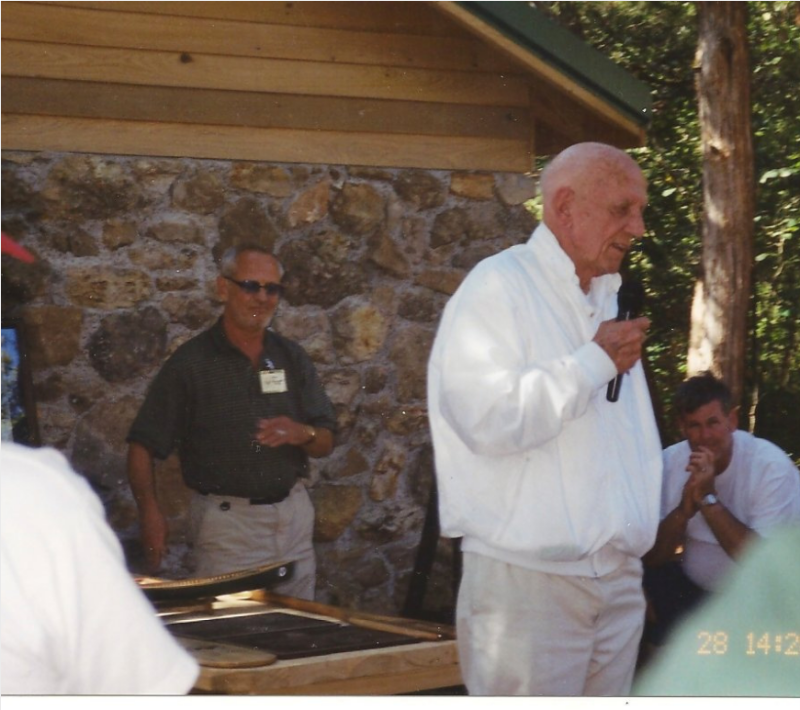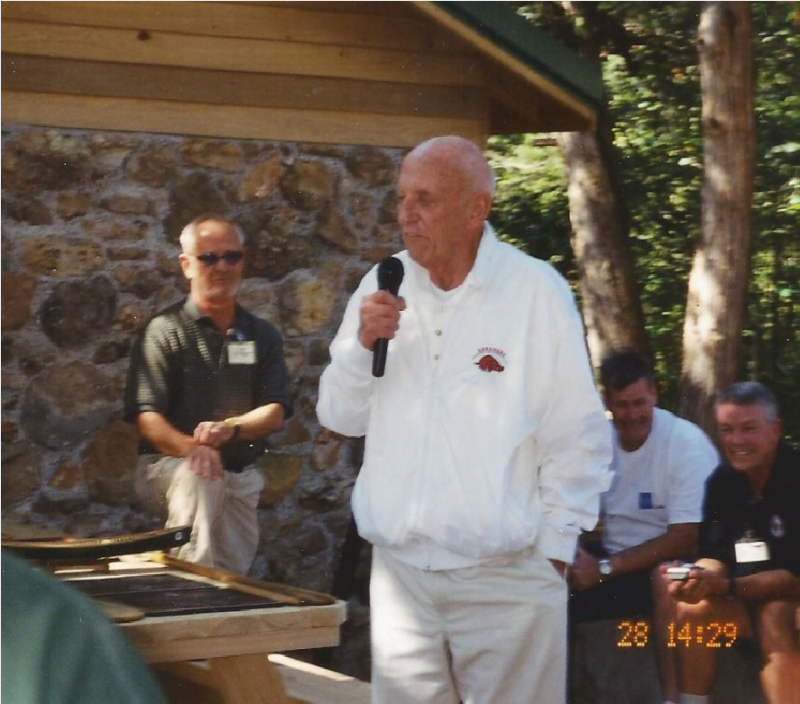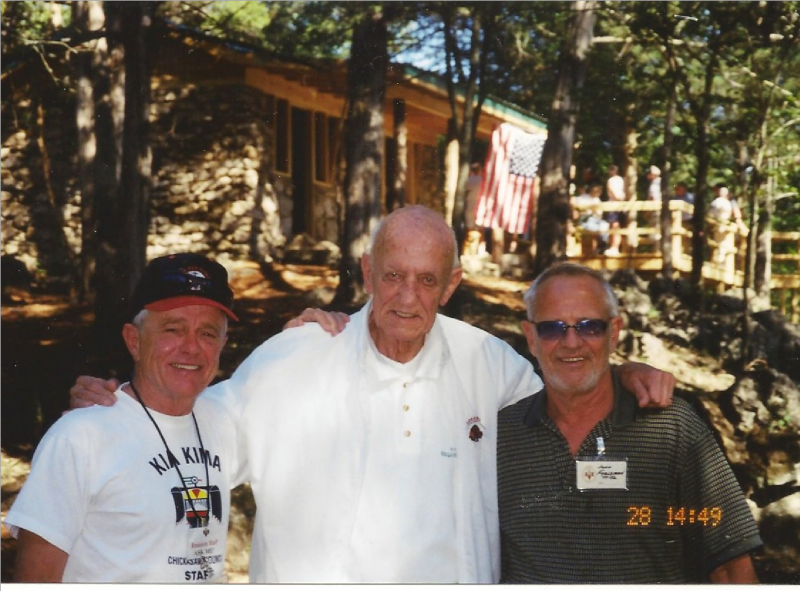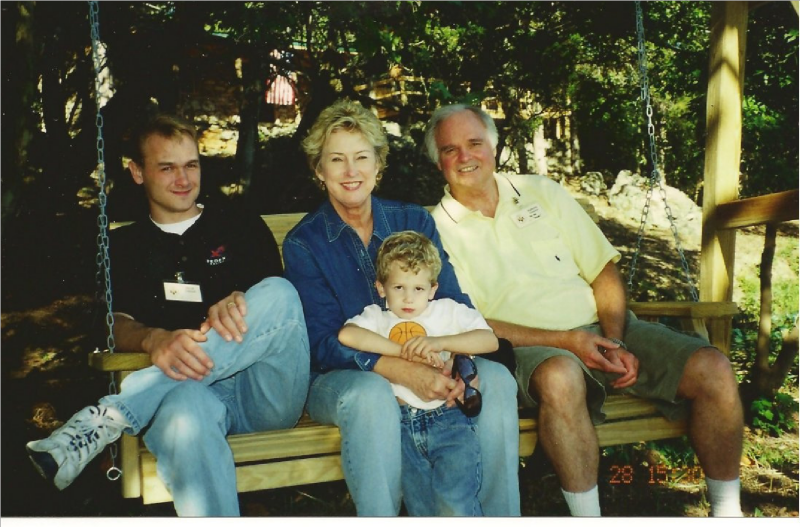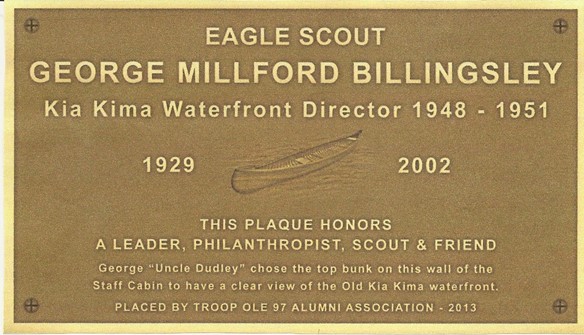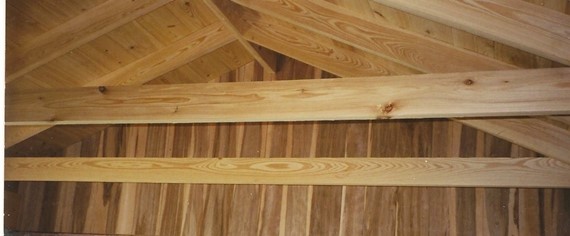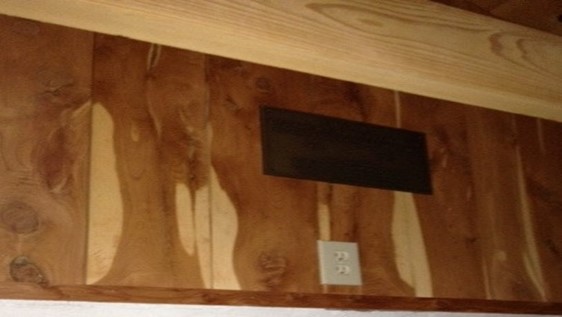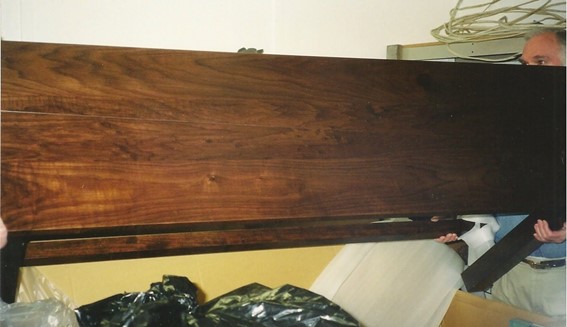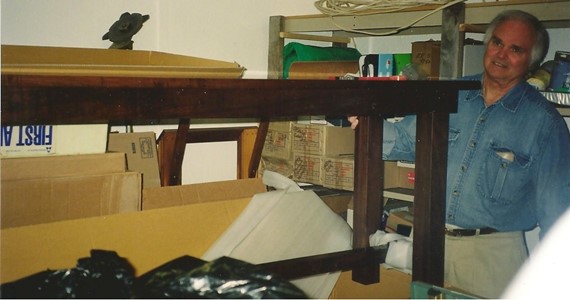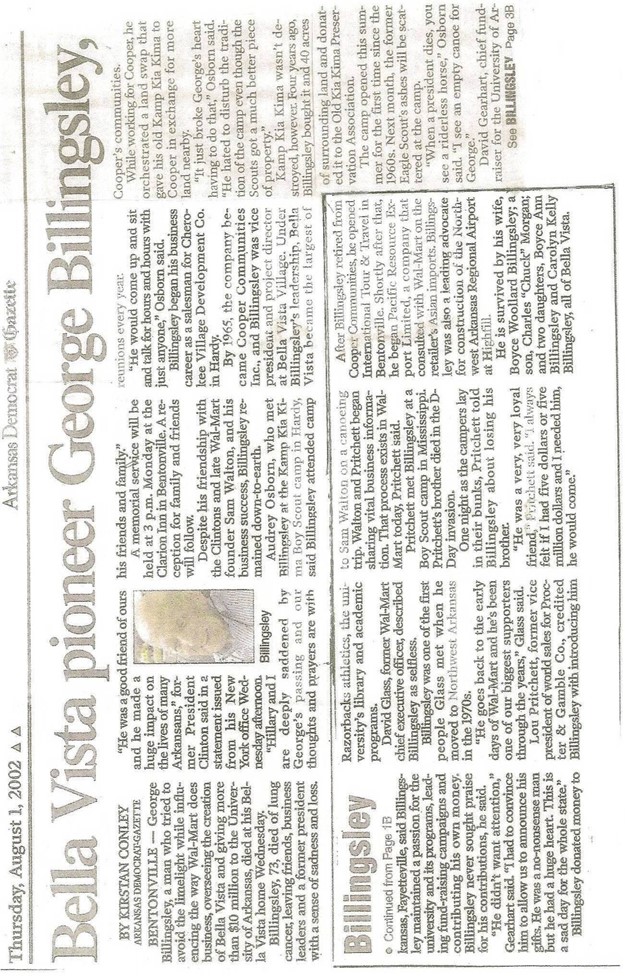Uncle Dudley’s Cabin
A story about George Billingsley
and the "Rat's Nest" staff cabin
by Audrey E. “Umpy” Osborn,
Ole 97 Eagle Scout 1954
"George said it was okay for me to sleep in their cabin."
In the winter of 1951, probably in February, Scoutmaster "Buddy" Irwin took Troop "Ole 97" camping at Camp Currier. I am sure he knew we would experience a very cold and uncomfortable night, sleeping on the ground. He knew the benefits of our learning to endure the cold winter night by improvising and adapting to harsh, new situations.
We were camping at Peckerwood Point, our favorite place to camp in those days. We had set up our tents and lean-tos off to the left side of the ridge. This was before we got the new tents that leaked. Using much innovation, we all built the best shelters we could. Our goal was to protect ourselves from the wind. There would be three to four working together to construct their shelter.
I didn’t have a sleeping bag, only a shelter-half for a ground cloth and two blankets. After our campfire, we all bundled up close together in our shelters and tried to stay warm and go to sleep. This was going to be difficult to do this night. The wind was still howling through the tall red oaks and poplars but at last I did manage to drift off to sleep.
After a couple of hours, probably around midnight, I woke up chilled to the bone. It was much colder and the wind was still howling and I thought I would freeze to death. I sat up and looked around to see that my tent buddies were not there. I figured they had gone to the platform tents up on the ridge around the log cabin. I grabbed my sleeping gear and went to the platform tents. Each one of the tents appeared to be filled.
Finally, the last tent I looked into, only three big guys were in there talking. I asked if there was room for me. One of the guys I recognized from summer camp said, “I’m George Billingsley.” I told him I knew he was the waterfront director at Kia Kima last summer in 1950. I had been scared to death of his booming voice back then. He asked what Troop I was in and then said it was okay for me to sleep in their cabin.
I asked George, “Uncle Dudley”, how long he had been in the Boy Scouts, he told me he had been a Scout for ten years. I thought that was a lifetime. I was only 12 ½ years old. For some reason that made a huge impression on me. I hoped someday to be a veteran Scout like George. He was the waterfront director at Kia Kima from 1948-1951. Our paths crossed again at Kia Kima summer camp in 1951.
Forty-six years later, at the Old Kia Kima Preservation Association reunion at Cherokee Village in September 1997, I had a chance to talk with George. I shared with him my sales endeavors throughout Asia, marketing hardwood lumber. I knew he was involved with PREL, a company that supplied Walmart with much of their products. I wanted him to know that another OKK Scout was flying the friendly skies, knocking on doors and visiting the mysterious cities and countries of Asia.
Dorris Goodman, my hero and Ole 97 Alumni, Kia Kima staffer 1948-1952 and old friend of George’s, was also present. They had a great time together and reminisced about many things including an event that occurred in March of 1950, prior to summer camp.
Bobby Harriss recounted the event as follows: That Saturday night in March was the last night of the Boy Scout Exposition. It was held in the Shelby County Building at the Fair Grounds. Dorris Goodman, Bobby Harriss, Bobby Williams and Bill Oberle, under the watchful eye of George Billingsley, demonstrated the proper way to paddle and handle a canoe. After the Exposition closed and the pond display dismantled, George decided to drive to Hardy to check out the Kia Kima waterfront. They were all in agreement but first they had to help Dorris throw his paper route. With a light rain falling and twilight dawning and Bobby Harriss at the wheel of George’s old green Chevy, they headed to Hardy and Kia Kima.
Now, in the winter of 1950, the words to the famous song “It’s a long way to Kia Kima” went like this, “It’s a long way to go" …. "but my heart’s right there,” an understatement for this group of five eager Kia Kima staffers. After about three hours on old US 63, loaded with potholes, and a fourth hour on gravel that forded all the creeks, the weary crew would finally reach Hardy. They turned left on US 62, crossed the railroad and slowly crossed the creaky, rattling old Spring River Bridge and on past Rio Vista that, no doubt, had the only jukebox in the county. After another mile of gravel road the exhausted crew arrived at Miramichee and the ford crossing the Southfork River. Much to their dismay, the river was too high to ford in a car! Their only option was to try fording the Spring River at Humphrey’s Ford.
That worked out fine and after another three or four miles of back country gravel roads they finally passed camp ranger Burl Burnside’s house. Now, almost there, Bobby pulled the wore-out green Chevy into the quadrangle and instantly the crew felt new energy on arriving in front of the old wooden mess hall. At long last, they had arrived and it felt good. It had been almost a year since they had last breathed the unique, fragrant Kia Kima air. Their hearts no doubt were beating in unison as they walked between the mess hall and Thunderbird Lodge. Through the tall fragrant cedars, they headed downhill to the mighty Southfork at “the point.” The river never looked so good and they reached down and let the cold Southfork water run through their fingers. They stood there looking across the river thinking about the summer camp staff of 1950, now only a few months away. On a low bluff, a short distance beyond a small branch, their old staff cabin the “Rats Nest” beckoned to them and a quick visit was made as each heart beat faster. They all agreed it was well worth the trip to be there once again. Now, four of the guys wondered what they should do next! George had the answer, “Let’s go to the car. We’re going home!”
George purchased Old Kia Kima and 46 acres in 1998. During the 1999 OKKPA reunion, I became aware that George and I had an in-depth interest with South East Asia. George told me about PREL International, exclusive buying agent for Wal-Mart & Sam’s Club, with executive offices in Hong Kong, of which he was Chairman and CEO. He told me an interesting story about the 1997 New Year’s Day transition of Hong Kong from Great Britain to China. He was in attendance with the incoming Chinese Governor’s celebration party. They were in the penthouse of a skyscraper in Hong Kong overlooking the bay and Kowloon, watching the magnificent fireworks display! I can’t imagine just how beautiful that must have been. The view was always breathtaking to me without fireworks.
At the 1999 OKKPA reunion, a plan was presented to restore all 16 of the stone cabins. A four-thousand dollar donation would restore a cabin in one’s honor. I was confident that if I could create an Ole 97 Alumni roster, we could raise a sizeable sum of money for a larger project like renovation of the Thunderbird Lodge. What we donated would be a memorial to Buddy Irwin for his 51 years as Ole 97 Scoutmaster. This effort resulted in a $29,483 gift to the OKKPA at the 2000 reunion.
George was interested that the Ole 97 Alumni were motivated to donate such a large amount in less than a year and with such a large number of donations. I think George, through our efforts, saw the “Spirit of Scouting” was alive. It was around this time George told me his number one priority was to see the restoration of his staff cabin, the “Rat’s Nest.” I had no idea why he told me this about his staff cabin. It was off the radar with all restoration interest focused on cabins and the Thunderbird Lodge.
Early in 2000, I planned a trip starting in Singapore then Kuala Lumpur, Hong Kong and Tokyo. I tried to contact George about arranging a meeting for me with the president of PREL, Charles Wong. George was not home or in his office before I left on my trip. Finally, I reached him from Kuala Lumpur one day before arriving in Hong Kong. He fussed a bit for not having more notice but said he would have my appointment information at the Hyatt when checking-in the next night.
When I arrived, there was a note confirming my meeting the next morning at 8:30 a.m. with President Wong. That night about 11:00 p.m., my room phone rang and the gravelly voice of Uncle Dudley asked if I had received a note from Mr. Wong about my appointment. It made me feel kind of special that George would follow up, calling me from the other side of the world. I think that was a trait that made George unique.
It was early in 2001 when I heard the news that George had lung cancer. “How much time does he have?”, I wondered, remembering what he had told me about his number one priority, restoration of his staff cabin, the “Rats Nest.” “Stay clear of that cabin,” is all I ever heard through my years as a young Scout at camp. All I knew about it was what I could see from a distance. I knew that it had been added on to through the years and looked awful. I had never felt an urge to venture inside. Now, I had little time to bring George’s cabin to life before he would probably be too ill to travel.
However, I would do my best to make George’s wish possible. What would be the cost and how could those funds be raised before the reunion in about ten months? I needed an urgent plan to accomplish Uncle Dudley’s wish of restoring the cabin to its original configuration with added changes. I knew quick action must be taken if George would see the “Rat’s Nest” restored.
I already had an extensive sales trip scheduled to South East Asia in March and a confirmed appointment with Alex Hsu, Executive V.P. of PREL, located in Taipei, Taiwan. I would make a presentation to Alex about donating the reconstruction cost of George’s cabin. During my meeting, Alex told me George talked frequently about his old Boy Scout camp in Arkansas but had never shown him any pictures. Alex was impressed to see my pictures of the restored stone cabins covered in a beautiful winter snow. In answer to my presentation, Alex said he saw no problem in getting approval from their president, Mr. Wong, whom I had already met, to provide the funds necessary for the restoration and to keep it a secret. He would have an answer from their president before I departed Singapore. With a confirmed "yes" from Charles Wong, all I could think about on the twenty-one hour flight home was restoration of the “Rat’s Nest.”
I presented Hsu’s email answer and my vision of making George’s cabin into a “Show Place” to everyone at the OKKPA April 2001 work week. I proposed the added-on rooms would have to go, a spacious deck added and all existing wood be replaced with native hardwoods. I proposed a pecan and hickory floor be added with Louisiana Cypress rafters, roof decking, wall and window framing and doors with the center gables paneled with Red Cedar and the inside end gables paneled in Sweet Gum with Hackberry trim. Use of these common southern hardwoods would bring warmth, beauty and personality to the simple cabin, showing an interest in detail that off the rack pine building material can’t imitate. The spacious deck would provide a great view of the Southfork and a good place to grill while looking at the Old Kia Kima waterfront, a view George loved and was visible from his top bunk on the inside wall of the “camp-side" room.
Our goal was to have the cabin at least partially completed before our OKKPA Reunion and hoped George would at least be able to make a short visit to the 2001 OKKPA Reunion. We surveyed the cabin and made an assessment of what should be done and plans to get started ASAP. This was my first time to go inside the cabin and immediately l knew my vision to remove all the additions including all the wood on the original stone cabin was correct. There was some debate that renovation of the additions would make a more useful cabin but a clear vision prevailed. The concrete slab of the added rooms would make a great patio for the addition of a deck. The OKKPA board accepted PREL’s offer, my vision and started renovation with a goal to complete as much as possible before the September 2001 reunion. Everyone agreed, this would make a perfect memorial to “Uncle Dudley” and the other staff who stayed in the historic “Rat’s Nest.”
At last, we were underway with the cleanup and removal of all the additions and wood on the original two-room stone cabin. The stone wall that had been removed for addition of the other rooms was replaced. I was proud of the stone work on the replacement wall; it would border one side of our new concrete patio. We also decided on the configuration of the wood deck, we would anchor the end of the deck to the old abandoned septic tank and maximize the deck around the large trees.
I worked up what was needed for the Cypress framing, decking and flooring. Gremillion Millwork in Alexandria, Louisiana, would make three Cypress doors, Pecan and Hickory flooring and the Sweet Gum paneling. They also planed and sanded all the other cypress material I had selected for color and character. Everything was coming together, as I hoped, and Bobby William’s crew was doing a good job of getting the cabin constructed into its future glory.
We did research to find all the staff who bunked in the “Rat’s Nest” with George from 1948 through 1951. We placed a bronze plaque on the wall between the cabin doors with all the staff names.
George was able the make a short visit to the 2001 reunion and was pleased to inspect his beloved old staff cabin for the last time. We set up a table and microphone on the concrete patio for any remarks George may have about his beloved Old Kia Kima. With a clear view of the waterfront he loved, we gave a hearty “How-How-UG” to our beloved waterfront director, “Uncle Dudley.” It was an excellent time for picture taking.
Shortly after the reunion, the cabin was completed and outfitted with bunk beds. I also had a Pecan table made especially for the “Rat’s Nest” by Chita Karimoku. They were Japan’s premiere furniture manufacturer and one of my best customers. The beautiful table was carefully packed and shipped, arriving sometime after the “Rat’s Nest” was completed. I thought it would be appreciated as something of value and fit in as a game or writing table. I thought the proper place for the table was on the inside wall where George’s upper bunk was located.
The last artifact to be installed was a bronze plaque donated by the Ole 97 Alumni Association. It was to be affixed on the concrete wall at eye level and easy to read where “Uncle Dudley’s” top bunk was during his time on the Kia Kima Staff. This position enabled George to have the waterfront in view while lying in bed. The plaque pictured an empty canoe, afloat, without its beloved canoeist.
Unfortunately, due to the difficulty of attaching the plaque to the concrete center wall, the plaque was installed above the concrete wall up in the wood gable about eight feet above the floor, too far up to read anything on the plaque except George Billingsley. Consequently, the beautiful rosette head screws for concrete installation with expansion bolts weren’t used, they were very expensive. “After all that George did to help Old Kia Kima, I would have hired someone with the equipment to properly install the plaque”.
This story is dedicated to the memory of a True Scout, my friend, George M. Billingsley, “Uncle Dudley,” who died July 31, 2002. He was 73.
Uncle Dudley, George’s nickname, how did it originate? I asked his waterfront assistant “Lou Pie” Pritchett, he didn’t know and suggested I contact the all-knowing and learned Kia Kima staffer, John A. Fogleman. It seems that way back in the 40’s there was an information guru, a wannabe Ann Landers. The newspaper column was called, you guessed it, “Uncle Dudley Says” and gave valued information and direction to those in need. In those early days of Kia Kima’s reopening, one can imagine the many questions about a Southfork River waterfront. So, ready or not, George became the “Uncle Dudley” of the Southfork, from a tower with a whistle on a lanyard around his neck. And, I almost forgot, a megaphone that could be heard all the way to Cedar Bluff!
Audrey E. “Umpy” Osborn - February 18, 2006, Revised July 2, 2015
© Copyright “Uncle Dudley’s Cabin” July 2015 by Audrey E. “Umpy” Osborn
